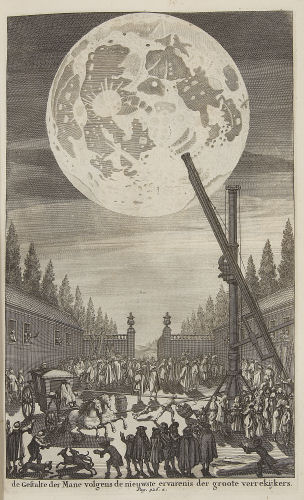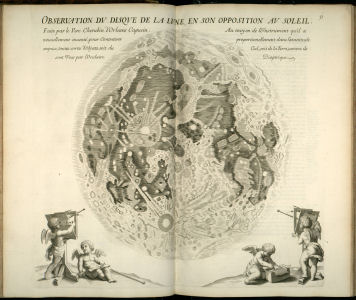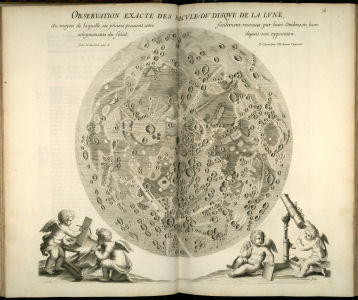 |
|
In my research on Dutch celestial cartography, I have found several lunar maps in non-astronomical works such as on theology. Usually, the original sources on which these lunar maps were based are not difficult to determine.
However, the lunar map discussed on this webpage is quite unusual. The copper plate etching, probably engraved by the Amsterdam draughtsman Jan Goeree (1670-1731), measures about 17 by 27½ centimetres and is bound in the second volume of his father’s Voor-bereidselen tot de bybelsche wysheid, en gebruik der Heilige en kerklijke historien (Amsterdam, 1690).
This popular work by the Amsterdam bookseller Willem Goeree (1635-1711), the Dutch title of which can be translated as Introduction into Biblical Wisdom and the Use of the Holy and Ecclesiastical Histories, contains numerous large copper plate prints illustrating the creation of the world, the Biblical Flood (with details on the building of Noah’s Ark), the history of the Holy Land and also includes several scenes depicting astronomy and natural history.
Goeree’s work was reprinted in 1700 by the Utrecht booksellers Anthony Schouten and Hermannus Ribbius. The copper plates from this work were also used in the 51st volume (describing the Holy Land) of Pieter van der Aa’s monumental La Galerie Agréable du Monde, published in 1729 in Leiden in 66 volumes.
In this print the engraver has skilfully combined contemporary astronomical knowledge and public interest in such matters into a vivid composition. Frustratingly, both the text as the caption at the bottom of the print, which can be translated as “The Appearance of the Moon according to the Newest Information from the Largest Telescopes”, give little information on the pictorial sources used by the engraver.
|
More helpful is another copper plate etching bound in the same work which depicts telescopic drawings of the planets evidently copied from the Selenographia sive Lunæ Descriptio, published in 1647 by the Polish astronomer Johannes Hevelius (1611-1687). Many of the details on the lunar map can also be matched with the lunar maps found in the same work.
It would be natural to assume that the telescope shown in the foreground (a second telescope appears to be depicted at the far left in the courtyard but it is difficult to make out details) was also copied from the same work, or one of his later works which depict numerous telescopes of different designs. However, none of the telescopes depicted in the works of Johannes Hevelius appear to match the telescope on the print.
In fact, a nearly perfect match can be found with a telescope described in La Dioptrique Oculaire, an influential work on optics and lens grinding published in 1671 by the French Capuchin friar Chérubin d’Orléans (1613-1697), who baptismal name was Michel Lasséré.
In the same work, Chérubin gives two magnificent lunar maps which are claimed to be based upon his own lunar observations. However, a comparison with the lunar maps in the Selenographia of Hevelius leave no doubt that they were in fact copied from this work.
???
???
???
 |
 |
|
|
The lunar maps bound in La Dioptrique Oculaire of Chérubin d’Orléans. Both copper plates were engraved by Louis Coquin. |
||
It is also interesting to compare the telescope depicted above with another copper plate etching by Jan Goeree of a telescope set on Bolwerk Osdorp, a bastion in the Amsterdam city walls, near the Leydsche Poort. According to the caption the etching was based on a drawing dating from 1690.
|
It is tempting to identify this telescope with that of Nicolaas Hartsoeker (1656-1725), a noted Dutch scientist and lens grinder who worked for the Paris Observatory and Academy and also made numerous observations of the lunar surface.
But chronologically, there is a problem as Nicolaas Hartsoeker ???.
Literature
I gratefully acknowledge the comments made to an earlier version of this webpage by Huib J. Zuidervaart.
Return to my homepage
[document last updated on 16 February 2009]